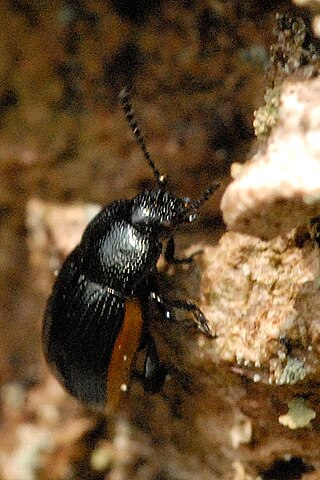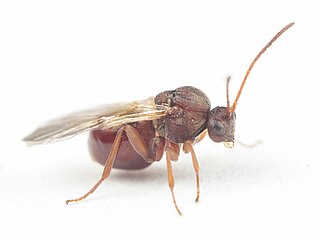
Liquorice or licorice is the common name of Glycyrrhiza glabra, a flowering plant of the bean family Fabaceae, from the root of which a sweet, aromatic flavouring is extracted.

Ulmus glabraHudson, the wych elm or Scots elm, has the widest range of the European elm species, from Ireland eastwards to the Ural Mountains, and from the Arctic Circle south to the mountains of the Peloponnese and Sicily, where the species reaches its southern limit in Europe; it is also found in Iran. A large deciduous tree, it is essentially a montane species, growing at elevations up to 1,500 m (4,900 ft), preferring sites with moist soils and high humidity. The tree can form pure forests in Scandinavia and occurs as far north as latitude 67°N at Beiarn Municipality in Norway. It has been successfully introduced as far north as Tromsø and Alta in northern Norway (70°N). It has also been successfully introduced to Narsarsuaq, near the southern tip of Greenland (61°N).

Bougainvillea is a genus of thorny ornamental vines, bushes, and trees belonging to the four o' clock family, Nyctaginaceae. They are native to Brazil, Bolivia, Paraguay, Peru, and Argentina. There are between 4 and 22 species in the genus. The inflorescence consists of large colourful sepal-like bracts which surround three simple waxy flowers, gaining popularity for the plant as an ornamental. The plant is named after explorer Louis Antoine de Bougainville (1729-1811), after it was documented on one of his expeditions.

Goupia is a neotropical genus of flowering plants and the sole genus included in the family Goupiaceae. There are three species, all found in tropical northern South America.

The Megaspilidae are a small hymenopteran family with 13 genera in two subfamilies, and some 450 known species, with a great many species still undescribed. It is a poorly known group as a whole, though most are believed to be parasitoids, and a few hyperparasitoids. Many are found in the soil, and of these, a number are wingless.

Grewia is a large flowering plant genus in the mallow family Malvaceae, in the expanded sense as proposed by the Angiosperm Phylogeny Group. Formerly, Grewia was placed in either the family Tiliaceae or the Sparrmanniaceae. However, these were both not monophyletic with respect to other Malvales - as already indicated by the uncertainties surrounding placement of Grewia and similar genera - and have thus been merged into the Malvaceae. Together with the bulk of the former Sparrmanniaceae, Grewia is in the subfamily Grewioideae and therein the tribe Grewieae, of which it is the type genus.
Maiestas glabra, formerly Recilia glabra, is a species of bugs from the Cicadellidae family that is endemic to Zhejiang province of China. It was formerly placed within Recilia, but a 2009 revision moved it to Maiestas.

The Sclerogibbidae are a small family of aculeate wasps in the superfamily Chrysidoidea.

Hydrothassa glabra is a Europe species of leaf beetle in the family Chrysomelinae

Oberea linearis is a species of beetle in the family Cerambycidae. It was described by Carl Linnaeus in 1761, originally under the genus Cerambyx. It has a wide distribution throughout Europe. It is preyed upon by Opilo pallidus, and serves as a host for the parasitic wasp species Dolichomitus messor and Phaenolobus terebrator. It feeds on Juglans regia, Corylus avellana, Ulmus glabra, Ostrya carpinifolia, and Carpinus betulus. It contains the varietas Oberea linearis var. parallela.
Crabro tumidus is a species of square-headed wasp in the family Crabronidae. It is found in North America.
Oxybelus emarginatus is a species of square-headed wasp in the family Crabronidae. It is found in North America.
Pristaulacus strangaliae is a species of wasp in the family Aulacidae and the order Hymenoptera found in North America. They are diurnal.
Conostigmus erythrothorax is a species of Megaspilid wasp in the family Megaspilidae.
Trichosteresis is a genus of Megaspilid wasps in the family Megaspilidae. There are at least three described species in Trichosteresis.

Ammophila pictipennis is a species of thread-waisted wasp in the family Sphecidae, found in the eastern half of North America.

Hydromyza is a genus of dung flies in the family Scathophagidae. There are at least three described species within the genus Hydromyza.

Heteroecus is a genus of gall wasps in the family Cynipidae. There are about seven described species in the genus Heteroecus.
Heterelmis glabra is a species of riffle beetle in the family Elmidae. It is found in Central America and North America. The largest populations of this riffle beetle are found in springs associated with the upper Devils River in south-central Texas. Spring-adapted organisms such as this beetle have life-history patterns requiring surface components, which makes them more vulnerable to changes in spring flow that alter the surface habitat.











